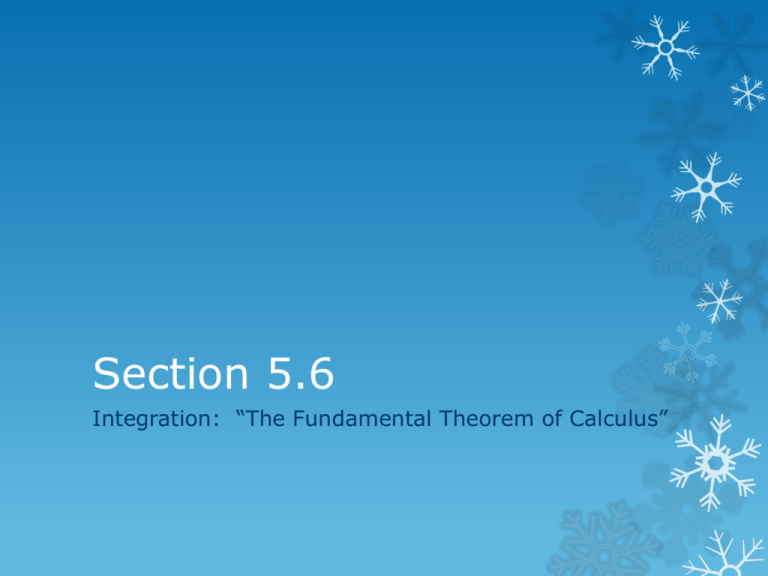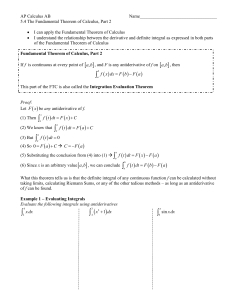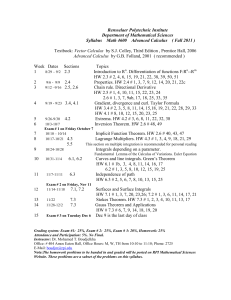
Section 5.6
Integration: “The Fundamental Theorem of Calculus”
All graphics are attributed to:
Calculus,10/E by Howard Anton, Irl Bivens, and Stephen
Davis
Copyright © 2009 by John Wiley & Sons, Inc. All rights
reserved.
Introduction
In this section we will establish two basic
relationships between definite and indefinite
integrals that together constitute a result
called the “Fundamental Theorem of Calculus.”
One part of this theorem will relate the
rectangle and antiderivative methods for
calculating areas.
Another part will provide a method for
evaluating definite integrals using
antiderivatives.
Developing The Fundamental
Theorem of Calculus
We have already seen this area formula in section
5.5:
In section 5.1, we discussed that if A(x) is the area
under the graph of f(x) from a to x, then
A’(x) = f(x).
We also discussed that the area under the curve
from a to a is the area above the single point a,
which is zero (see graph above right). A(a) = 0.
A(b) = A which is the area we are trying to find
under the curve from a to b (see graph below rt)
Since A’(x) is an antiderivative of f(x), every other
antiderivative of f(x) on [a,b] can be obtained by
adding a constant to A(x) which we have already
discussed:
F(x) = A(x) + C
The Fundamental Theorem of
Calculus
Using F(x) = A(x) + C from the previous slide,
we can calculate F(a) and F(b) and consider
what happens when we subtract them:
F(b) – F(a) = [A(b)+C] – [A(a)+C]
= A(b) + C – A(a) – C
= A(b) – A (a) = A – 0 = A
o In words: The definite integral can be
evaluated by finding any antiderivative of the
integrand f(x) and then subtracting the value
of this antiderivative at the lower limit of
integration from its value at the upper limit of
integration.
The Fundamental Theorem of
Calculus
Example 1
Example 1 Results
The integral we just calculated gives us the area in the
picture below which is 1/3.
Notation
The formula that The Fundamental Theorem of
Calculus gives us is usually written with a
special notation.
Another Example
Warning
The requirements listed with the Fundamental
Theorem of Calculus that the function f must be
continuous on [a,b] and that F is an antiderivative
of f on [a,b] are important to keep in mind.
Disregarding these rules will often lead to incorrect
results.
Also, note that the Fundamental Theorem of
Calculus can be applied without any changes when
the lower limit of integration is greater than or
equal to the upper limit of integration (see
example #6 on page 366 if you have a question).
Relating the Rectangle
Method and the
Antiderivative Method
Relating the Rectangle Method
and the Antiderivative Method
(con’t )
Of course, the area A (or A(x)) will depend upon
which curve we are using.
We have already seen the following area formula
in section 5.5:
The second part of the Fundamental Theorem of
Calculus states that A’(x) = f(x) and we can use
this fact to help us calculate the area under the
curve using antiderivatives instead of rectangles.
Geometric Perspective in Relating
the Rectangle Method and the
Antiderivative Method
Fundamental
Theorem of Calculus
Part Two
Fundamental Theorem of
Calculus Part Two in Words
If a definite integral has a variable upper limit
of integration, a constant lower limit of
integration, and a continuous integrand f(x),
then the derivative of the integral with respect
to its upper limit is equal to the integrand f(x)
evaluated at the upper limit.
Example
Short way
Long way
Differentiation and Integration
are Inverse Processes
When you put the two parts of the
Fundamental Theorem of Calculus together,
they show that differentiation (taking the
derivative) and integration (taking the
integral) are inverse processes (they “undo”
each other).
It is common to treat parts 1 and 2 of the
Theorem as a single theorem and it
(formulated by Newton and Leibniz) ranks as
one of the greatest discoveries in the history
of science and the “discovery of calculus”.
Integrating Rates of Change
If you write the Fundamental Theorem of
Calculus in a slightly different form,
it has a useful interpretation.
Since F’(x) is the rate of change of F(x) with
respect to x and F(b) – F(a) is the change in
the value of F(x) as x increases from a to b:
Applications of Integrating Rates
of Change
The Mean-Value Theorem for
Integrals
To help better explain why
continuous functions have
antiderivatives, we need to use
the concept of the “average
value” of a continuous function
over an interval.
We look for a value of x (x*)
where the area of the shaded
rectangle will equal the area
under f(x) between a and b.
We find that value of x using the
following:
Example
Total Area
First divide the interval into
subintervals on which f(x)
does not change sign (see
diagram).
Calculate the absolute
value of the area of each
subinterval and add the
results.
We will do more of these in
section 5.7.
This is the new tip of my femur in
my metal hip.








